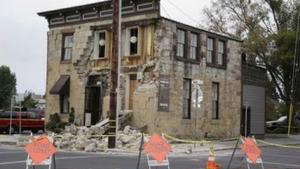Seismic safetySF posting seismic warning posters on vulnerable buildings in a retrofitting drive
In an effort to get property owners to retrofit vulnerable buildings, San Francisco is posting large signs — in English, Spanish, and Chinese, with red letters, and a drawing of a collapsed building — on apartment and hotel complexes that have failed to comply with the city’s seismic safety laws.The San Francisco tactic is similar to what city officials in Berkeley implemented in 2005, when building authorities placed small warning signs on at-risk wooden apartment buildings.

San Francisco begins campaign of warning posters on vulnerable buildings // Source: tubesfan.com
In an effort to get property owners to retrofit vulnerable buildings, San Francisco is posting large signs — in English, Spanish, and Chinese, with red letters, and a drawing of a collapsed building — on apartment and hotel complexes that have failed to comply with the city’s seismic safety laws.
“We wanted something that caught people’s attention, which I think this very well does,” said Patrick Otellini, San Francisco’s director of earthquake safety. “We saw that other programs had been wildly unsuccessful. We wanted a poster that drives change and lets people know what’s going on.”
The San Francisco tactic is similar to what city officials in Berkeley implemented in 2005, when building authorities placed small warning signs on at-risk wooden apartment buildings, and required property owners to send letters to tenants alerting them that their homes could pose “a severe threat to life safety.” The policy led to more than 100 buildings being retrofitted, and last year, Berkeley passed a law mandating all remaining 139 buildings be retrofitted.
San Francisco sent letters to property owners of roughly 6,600 buildings a year ago, asking them to fill out seismic retrofit screening forms, which will determine whether their properties will need evaluation for retrofitting. 90 percent of affected property owners have responded, but roughly 650 buildings are unaccounted for. The new signs are now being placed on buildings whose owners failed to complete the forms, which were due on Monday.
Emergency Management reports that many affected property tenants are criticizing the city’s new tactic. “You’re putting people in panic mode. That would be a horrible thing to put in a window. All you see is the words ‘earthquake warning,’” said Huy Le, who owns a salon in the Castro District and leases space underneath a hotel. “It’s almost as good as saying, ‘Don’t come into this building because it’s going to collapse.’” Other tenants support the sign as a public service. “I want to be safe,” said Katie Stephens, who rents a Marina District apartment. “That’s part of the responsibility of being a landlord in San Francisco. It may cost a lot, but what’s most important is that his tenants are safe.”
Roughly 4,000 wood-frame apartment buildings and hotels will need to be retrofitted under San Francisco law. Such buildings often house first-level hollow spaces like garages or storefronts, with limited structural support holding up the rest of the structure; so during a strong earthquake, seismic shakes can cause the upper floors to cave in on the first floor. Retrofitting these types of buildings could cost between $60,000 to $130,000, typically by inserting steel supports or new walls to the ground level. San Francisco city officials have recommended to property owners a group of local banks that have agreed to issue low-interest loans for financing retrofits.
The city of San Luis Obispo mandated retrofit of vulnerable brick buildings by 2015 following the collapse of a historic brick building in Paso Robles in the 2003 San Simeon earthquake, killing two people. Today, only fourteen of San Luis Obispo’s 126 vulnerable brick buildings have not been retrofitted. “Acknowledging the risk is the first step, but it’s not the last step,” said community development director Derek Johnson, referring to the city’s enforcement of a state law requiring that old brick structures display earthquake vulnerability signs. “More than anything, it (the signs) creates a real public awareness about the issue. … The public has the right to know.”
